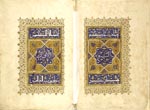Sacred at the British Library
Barnaby Rogerson is uplifted by an exhibition of rare and exquisite Christian, Muslim and Jewish texts, shown together for the first time at the British Library


Books are the most intimate of all art objects. The selection on show at a new exhibition in the British Library includes some of the rarest and most beautiful religious texts, many of which have never been on public display before. Once you have had time to adjust to the lighting and focus on the scale and detail of their pages, you will find yourself on a journey of total enchantment, travelling across 1,000 years and the shifting dimensions of the three Abrahamic faiths.
Among the treasures are St Cuthbert's own copy of the Gospels, with which he was buried in 687; golden pages torn by some lusty crusader from an extraordinary deluxe 6th-century Byzantine Gospel during the sack of Constantinople in 1204; and the gorgeous psalter commissioned by Henry VIII (who is instantly recognisable in a miniature, despite his King David like pose with a harp), bearing his own pencilled marginalia.
One of the world's oldest extant Korans is also on view, empty of the artistry and grace that we associate with the great schools of later calligraphy, but with its almost vowel-less black lines set out with the certainty of an inscription in stone. In terms of page design, nothing can match the delicate, carpet like intricacy of the Sultan Baybar's Koran, a manifestation of the word of God, commissioned to surpass even the magnificence of the mosque tombs of the Mameluke sultans in Cairo.
Then there is the full-throttle scholarship of the Walton polyglot Bible from 17th-century England to be marvelled at, with every last flicker of grammatical meaning made available to those who could work their way through the simultaneous translations in Aramaic, Syriac, Persian, Hebrew, Greek and St Jerome's Latin vulgate. It is also delightful to discover, within this world of cross-cultural linguistic fertilisation, that the Jewish scholar Maimonides the medieval Moses and the Aristotle of the Hebrews wrote in Arabic by preference and was forced to flee from fundamentalist persecution, taking refuge in the Muslim kingdom of Morocco. (Appropriately, this exhibition is part-funded by the present Moroccan government.)
The book that steals the breath away is the Melisende Psalter, made for a Crusader queen of Jerusalem. So astonishingly fresh are its colours and gilding that, at first, I assumed it to be a modern facsimile. Nobody has any idea how it survived the fall of Outremer in 1291, to re-emerge into the European art markets half a millennium later. Like so many of the sacred texts on display, it was conceived as an art object, one of the many treasures that were locked away in palaces, monastery libraries and the tomb shrines of kings.
Today, they have assumed a new public role as windows onto a vanished world, revealing much about its tastes, colours and aesthetics. The images still preserved in these books help us to visualise the interiors of churches, mosques and synagogues in all their original glory, because we know that they were repeated by artists like echoes of a sacred chant onto the frescoed walls of buildings, and onto objects such as textiles and wooden icons. Often barely legible now, their scripts drove saints to worship and warriors to war, or consoled a mother on the death of her child.
The exhibition leaves us with a deep satisfaction that these once ferociously separate spiritual traditions can be considered together in such harmony, their scriptures presented with equal scholarship, tolerance and respect. A new truth unites them; if we no longer believe that they were literally dictated by angels, we can pay even greater honour to the prophets and apostles who experienced the glory of the 'breath of God', and laboured to share that transforming experience with the rest of mankind. 'Sacred discover what we share' is at the British Library until September 23 (www.bl.uk)
Exquisite houses, the beauty of Nature, and how to get the most from your life, straight to your inbox.
Country Life is unlike any other magazine: the only glossy weekly on the newsstand and the only magazine that has been guest-edited by His Majesty The King not once, but twice. It is a celebration of modern rural life and all its diverse joys and pleasures — that was first published in Queen Victoria's Diamond Jubilee year. Our eclectic mixture of witty and informative content — from the most up-to-date property news and commentary and a coveted glimpse inside some of the UK's best houses and gardens, to gardening, the arts and interior design, written by experts in their field — still cannot be found in print or online, anywhere else.
